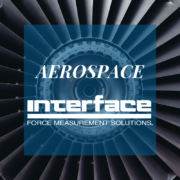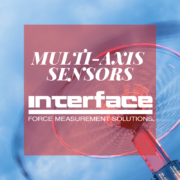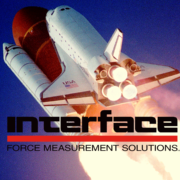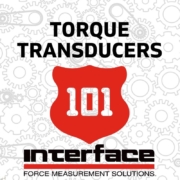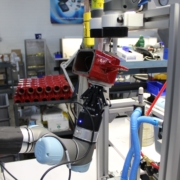Collaborative Robots Using Interface Sensors
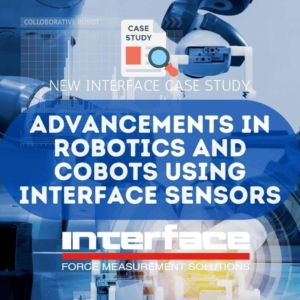 Industrial evolutions continue to find new and innovative ways to use technologies, from AI to advanced robotics. What is not changing over time is the unique ability for humans to solve challenges and create new solutions. Pairing human ingenuity with machines to increase efficiencies and productivity is what we see today with the fast growing use of collaborative robots.
Industrial evolutions continue to find new and innovative ways to use technologies, from AI to advanced robotics. What is not changing over time is the unique ability for humans to solve challenges and create new solutions. Pairing human ingenuity with machines to increase efficiencies and productivity is what we see today with the fast growing use of collaborative robots.
A cobot, short for collaborative robot, is a type of robot designed to work alongside humans in a shared workspace. Unlike traditional industrial robots, which are typically separated from human workers, cobots are designed to be safe and easy to use working side-by-side people. This interactivity is often referenced as part of moving from Industry 4.0 to Industry 5.0.
Cobots are typically equipped with sensors technologies that allow them to detect the presence of humans and react accordingly. This can include slowing down, stopping, or changing direction to avoid collisions or other safety hazards. Cobots are often used in tasks that are repetitive, dangerous, or require a high level of precision, such as assembly, packaging, or inspection.
One of the main advantages of cobots is their flexibility and ease of use. They can be quickly reprogrammed or taught new tasks, making them a cost-effective solution for many distinct types of manufacturing and assembly operations. Additionally, because they can collaborate with human workers, they can help to improve efficiency and productivity while also reducing the risk of injury or accidents.
In our new case study, Advancements in Robotics and Cobots Using Interface Sensors, we explore how are force measurement sensors used for cobots.
Force measurement sensors are often used in collaborative robotics to provide feedback on the force being applied during a task. This information can be used to ensure that the cobot is performing the task correctly and to detect any issues or errors that may occur. There are several types of force measurement sensors that can be used in cobots.
- Strain gage sensors: Interface uses proprietary strain gages in our load cells. Use of this type of sensor helps to measure the deformation of a material in response to applied forces. They are commonly used in cobots to measure forces applied to a gripper or end effector.
- Miniature load cells and load cell load buttons: Interface load cells of all sizes are used for both testing during design as well as embedded into the actual cobot for continuous monitoring. These types of sensors measure the force applied to a structure, such as a robotic arm or a part being manipulated by a gripper. Load cells can be used to ensure that the cobot is applying the correct amount of force to the part being worked on. Our smallest load cells are often used in the production and design of cobots.
- Torque transducers: Interface transducers are utilized to measure the movement of robots, in rotation and for pivotal activity. These are critical in tasks on production lines, as well in unique industry cobots, such as entertainment.
- Tactile sensors: These sensors measure the pressure or force applied to a surface. They are commonly used in cobots for tasks that require a high level of sensitivity, such as grasping and manipulating fragile objects.
Advancements in Technology Leads to Multi-Axis Sensors and Cobots
As use of cobots grows, so do the demands for using more data to define precision measured responses and actions. Multi-axis sensors can provide several benefits for cobots, as they allow for more accurate and precise sensing of the robot’s position, orientation, and movement. Here are some ways that cobots can benefit from multi-axis sensors:
- Improved accuracy: Multi-axis sensors can provide more accurate readings of a cobot’s position and orientation, allowing it to perform tasks with greater precision and accuracy. This can be particularly important for tasks that require precision accuracy, such as assembly or inspection.
- Enhanced safety: Multi-axis sensors can help to improve the safety of cobots by detecting when the robot is approaching an object or a person and slowing down or stopping to prevent collisions. This can be particularly important when cobots are working near human workers.
- Greater flexibility: Multi-axis sensors can allow cobots to perform a wider range of tasks, as they can adapt to changes in the environment or the task at hand. For example, a cobot with multi-axis sensors can adjust its position and orientation to grip an object from a variety of angles, or to perform a task in a confined space.
- Faster response time: Multi-axis sensors can provide real-time feedback on the cobot’s movement, allowing it to adjust more quickly and with greater accuracy. This can help to improve the speed and efficiency of the cobot’s performance.
Cobots are being used in a wide range of industries, as they offer benefits such as improved efficiency, precision, and safety. Some of the industries that are currently using cobots include:
- Automotive: Cobots are being used in the automotive industry for tasks such as assembly, material handling, and inspection.
- Electronics: Cobots are being used in the electronics industry for tasks such as assembly, testing, and inspection.
- Food and beverage: Cobots are being used in the food and beverage industry for tasks such as packaging, sorting, and palletizing.
- Medical: Cobots are being used in the medical industry for tasks such as assembly, inspection, and material handling.
- Pharmaceuticals: Cobots are being used in the pharmaceutical industry for tasks such as packaging, inspection, and dispensing.
- Aerospace: Cobots are being used in the aerospace industry for tasks such as drilling, riveting, and assembly.
- Plastics and rubber: Cobots are being used in the plastics and rubber industry for tasks such as injection molding, material handling, and inspection.
By using force measurement sensors, cobots can perform tasks with greater accuracy and precision, reducing the risk of errors and improving overall efficiency. They can also help to prevent damage to parts or products being worked on and ensure that safety standards are being met. Read the full case study below.
Advancement in Robotics and Cobots Using Interface Sensors Case Study
